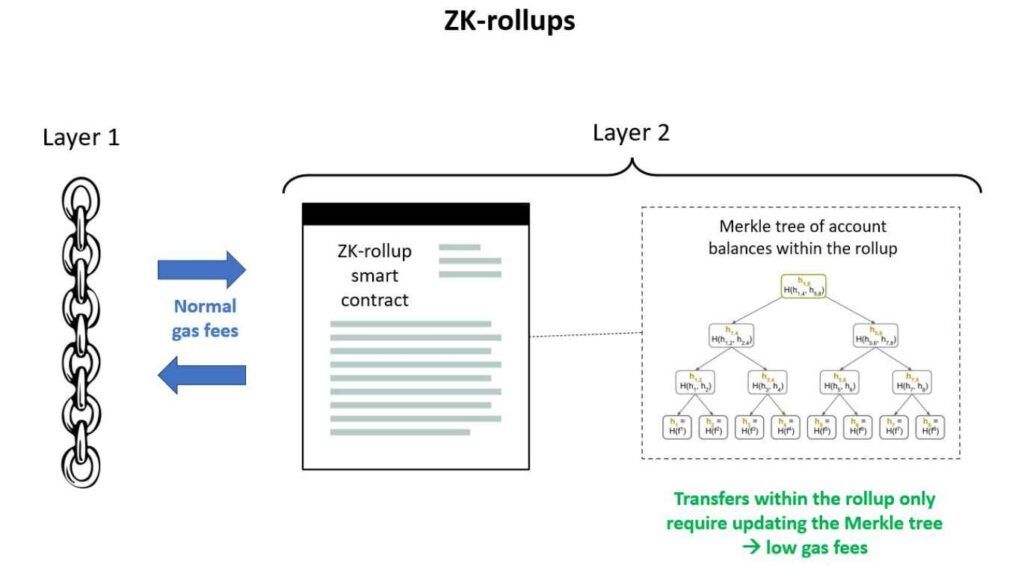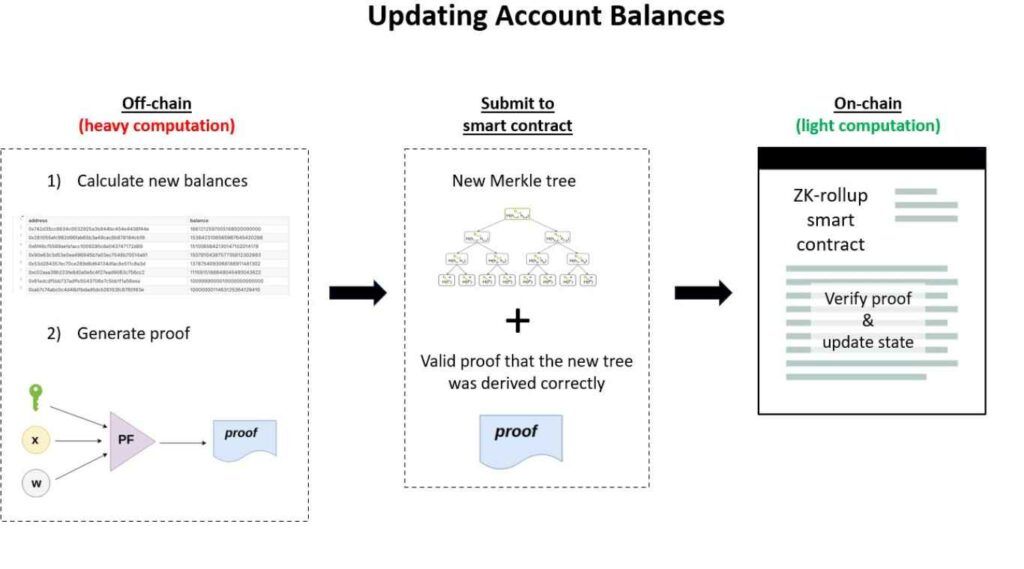The material presented here reflects the author’s viewpoints and investigation, and should not be considered financial guidance. The details provided are broad in scope and might not cater to the particular requirements of any individual or organization. This content should not be used as a basis for making professional or financial decisions.
Introduction
If you are a beginner or don’t have any technical knowledge and want to understand ZK rollups, how they work, and why they are so popular, don’t worry. I am going to explain it to you in a very easy way. But before that, you need to understand the basics of layer 1 and layer 2 blockchains, especially Ethereum.
What is Layer 1 Blockchain?
As you can see in the name “Layer 1”, this is the base layer of a particular blockchain. They are called “Layer 1 Blockchain.” Some Layer 1 Blockchain examples are Bitcoin, Ethereum, Binance Smart Chain, and Avalanche.
The Problem with Layer 1 Blockchain
The common problem with Layer 1 blockchain technology is that it is not scalable. When many users use a particular Layer 1 blockchain, the transaction fee will increase, and it will take more time than usual to validate the transactions.
What is Layer 2 blockchain?
The Layer 2 Blockchain was created to solve the problems with the existing Layer 1 Blockchain. The L2 blockchain is built on top of the existing L1 blockchain. whose goal is to make transactions more scalable, secure, and decentralized.
The problem in the Layer 2 solution
The main issue with a layer 2 blockchain is that it will lose its primary blockchain’s (L1) security and decentralization. They only solve the scalability issue. These blockchains have a high chance of getting attacked by an attacker who can steal all the funds or slow down the blockchain.
Types of Ethereum Layer 2 Solutions
These are the top 3 types of Ethereum Layer 2 solutions.
- State Channels
- Optimistic Rollups
- ZK Rollups
What are ZK Rollups?
The Zero-knowledge (ZK) rollup is a type of layer 2 solution that can be built on top of the existing Layer 1 blockchain and whose goal is to make the transactions faster, cheaper, scalable, secure, and private by not disclosing all the data or information while transacting with the verifier, unlike other Layer 2 solutions.
Why do we need ZK Rollups?
The blockchain industry is growing very fast. When we think about the next 5–10 years, the user base will grow 100 or thousand times more. So the blockchain has to be more scalable, secure, and decentralized.
But the problem with other Layer 2 solutions is that they are not secure enough. They are more concerned with the scalability issue, which will result in an exploit. ZK rollups have the potential to make transactions more scalable, faster, cheaper, secure, and private. This is the reason why the Ethereum community is focusing more on the ZK rollups.
How do ZK Rollups work?
Let’s say you want to send $100 to your girlfriend, but if you send it using a layer 1 blockchain like Ethereum, then your girlfriend will receive only around $90 or $95 and face transaction delays because of the high gas fees and scalability issues.
So you will send $100 through ZK rollup layer 2. because it’s so cheap, faster, and secure, and it also has privacy. Let’s look at why it’s the cheapest.

Cheap, faster, and scalable:
The ZK rollup combines your transaction with thousands of other people’s translations in a batch using a smart contract, then puts it in a Merkle tree inside the rollup. After that, it will be submitted to the L1 blockchain in one transaction.
Moving the balances within the ZK L2 is so cheap because it uses off-chain transfer. As you can see in the image, the Merkle Tree data only needs to be updated within the rollup. This is why it’s so cheap. Let’s understand how balances are updated using ZK rollups.

Off-Chain Transfer and Security:
If your Girlfriend sends you $100 using ZK rollup L2, it will generate a proof known as Zk-SNARKS or Zk-STARKS. Which is a cryptographic proof that allows one party to prove a particular piece of information without revealing it.
Validate transaction:
To check whether your Girlfriend’s cryptographic proof is fake or not, it has to be submitted to the roll-up smart contract. The smart contract requires correct proof to update the Merkle tree. So if your girlfriend is not lying, then the proof will be updated in the Layer 1 Merkle tree.
The ZK Rollup smart contract only approves a new transaction if the current snapshot hash matches the previous snapshot hash. If it’s matched, the new bundle of transactions will be updated in the Merkle tree with a new recent snapshot hash at that moment.
This is how ZK rollup ensures security and makes it impossible to cheat without revealing full information.
Private Transaction:
The update your Girlfriend made on the Merkle tree is fully transparent to the whole world. This is where the Aztec Network comes into play. The Aztec Network will create a privacy shield for transactions inside the rollup, which will allow two parties to do a private transaction without revealing the details of the balance and owner.
Must Read – How to do Fundamental Analysis On Crypto Projects
ZK rollups vs optimistic rollup
- Optimistic rollup and ZK rollup are both Layer 2 scaling solutions. They collect off-chain transactions in a batch and submit them to the Layer 1 blockchain in one transaction.
- Optimistic Security: Optimistic rollups use the Fraud Proof protocol. If one batch contained inaccurate data, they can still submit proof to the chain with the wrong batch. The contract validates the evidence and returns that batch, as well as all batches after it. It can cause a one-week delay in the transaction.
- Zk rollups Security: Zk rollup use validity proofs protocol. Every batch contains a cryptographic proof known as ZK-SNARK, which can be quickly verified on the chain. This is why it’s more secure and faster.
- Scaling – Zk rollup consumes fewer blockchain resources compared to Optimistic rollup. This is why it can be more scalable.
- Optimistic rollups are low-complexity technology compared to ZK rollups.
- Off-chain computation costs are low in the Optimistic rollups. It’s high in the ZK rollups because of the ZK-SNARK complex computation cryptographic method.
- Per-transaction on-chain gas costs are lower in the Zk rollup compared to optimistic rollups.
What Vitalik said about ZK Rollups
Here is what Vitalik said about Zk rollups in an ETHSeoul event.
In my opinion, ZK-Rollups will eventually outperform Optimistic Rollups in the long run since they have inherent benefits such as not requiring a 7-day withdrawal period. In more than ten years, if not more, I predict the rollups to be all ZK.
– Vitalik Buterin
At the same time, ZK technology is extremely difficult to develop. There are many mental obstacles, especially in completing all of this securely and making sure all of the circuits are properly powered. Optimistic roll-up technology is just more mature.
Top ZK Rollups Projects
Here are some of the best ZK rollups projects:
- zkSync
- StarkNet
- Polygon Zero
- Syscoin
- Dusk Network
- Loopring (LRC)
- Immutable X (IMX)
- dYdX
Must Read – How to Build a Profitable Crypto Portfolio
Pros and Cons of Using ZK Rollups
Pros
- Gas cost per data transfer is low.
- Stores data required to recover the off-chain state on L1, ensuring security, decentralization, and censorship resistance.
- Each transaction just contains the SNARK proofs rather than the entire data set, which increases scalability.
- It is faster than Plasma
- It is more secure than other Layer 2 solutions.
Cons
- Due to the intricacy of zero-knowledge technology, creating EVM-compatible ZK-rollups is challenging.
- Transactions can be ordered differently by centralized operators (sequencers).
- The sequencing of transactions can be affected by centralized operators (sequencers).
- Some proving systems (e.g., ZK-SNARK) need a trusted setup, which, if mismanaged, might possibly compromise a Zk-security rollup’s model.
- The expense of computing and confirming validity proofs is significant, and it can raise fees for rollup users.
Conclusion
The conclusion is that ZK-Rollups are not only an abstract concept. The transaction rate for the ZK-Rollup market that Loopring has developed is already 2,500 per second. A throughput of up to 2,500–10,000 requests per second is what the Ethereum developers predict might be achieved by combining rollups with sharding.
ZK-Rollups are not yet fully developed. It is in the development stage, so it will take its own time. The team requires a lot of work before a complete implementation.
Read – What is Metis Dao? (optimistic rollups project) is the Best Layer 2 solution right now.
CryptoGlobally aims to offer impartial and trustworthy data on cryptocurrency, finance, trading, and shares. Yet, we can't give financial guidance and encourage individuals to conduct their own studies and thorough checks.